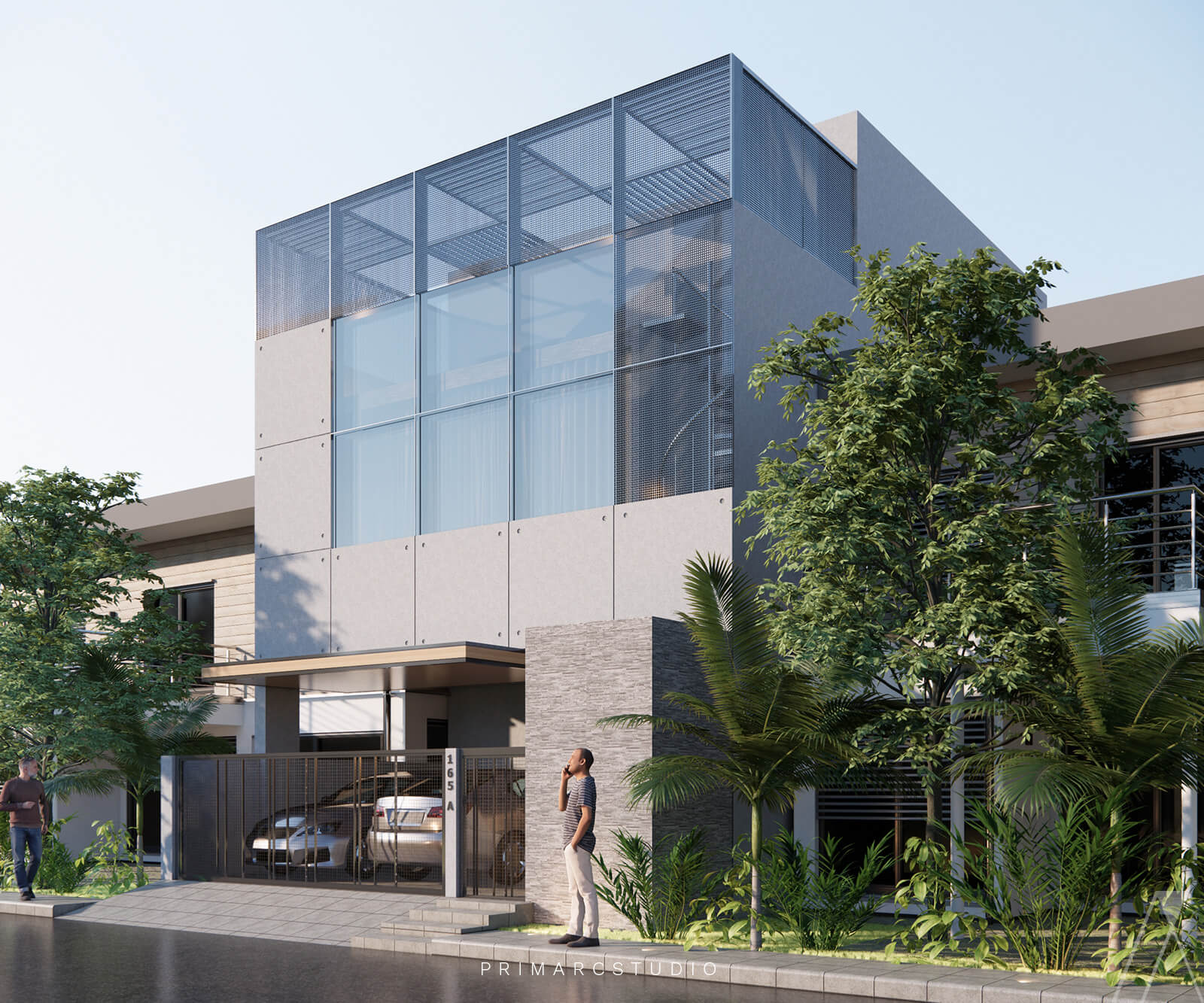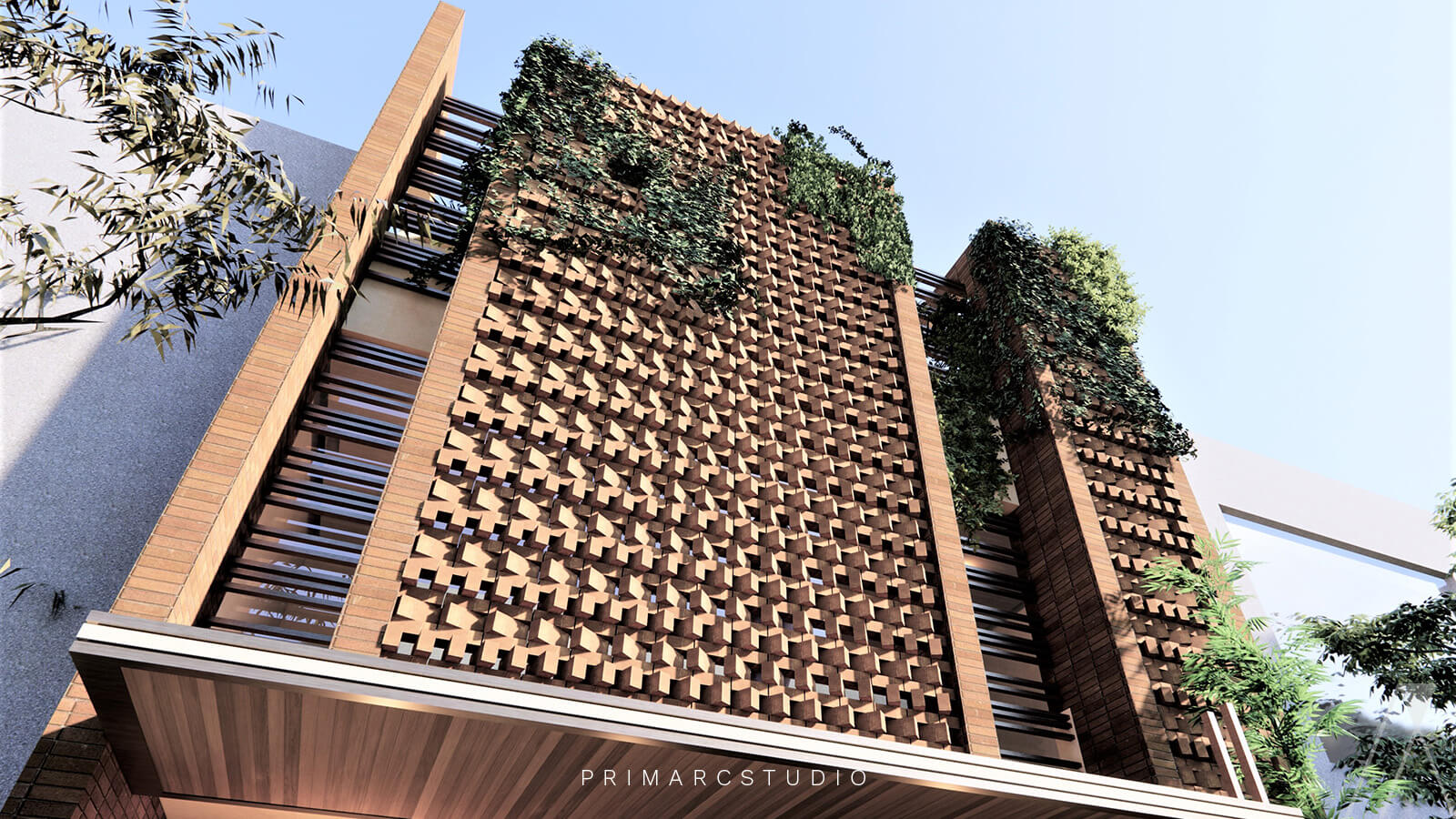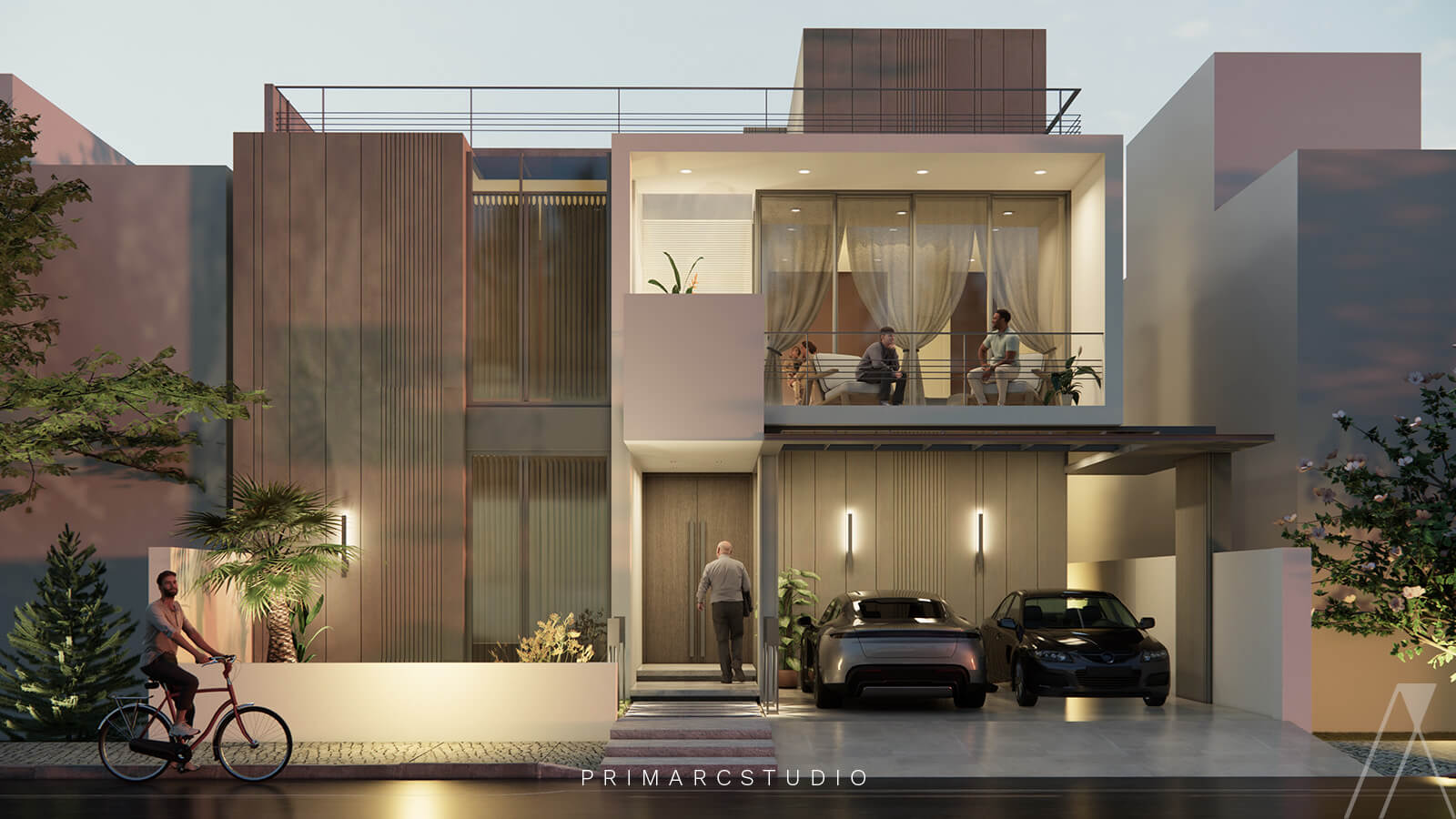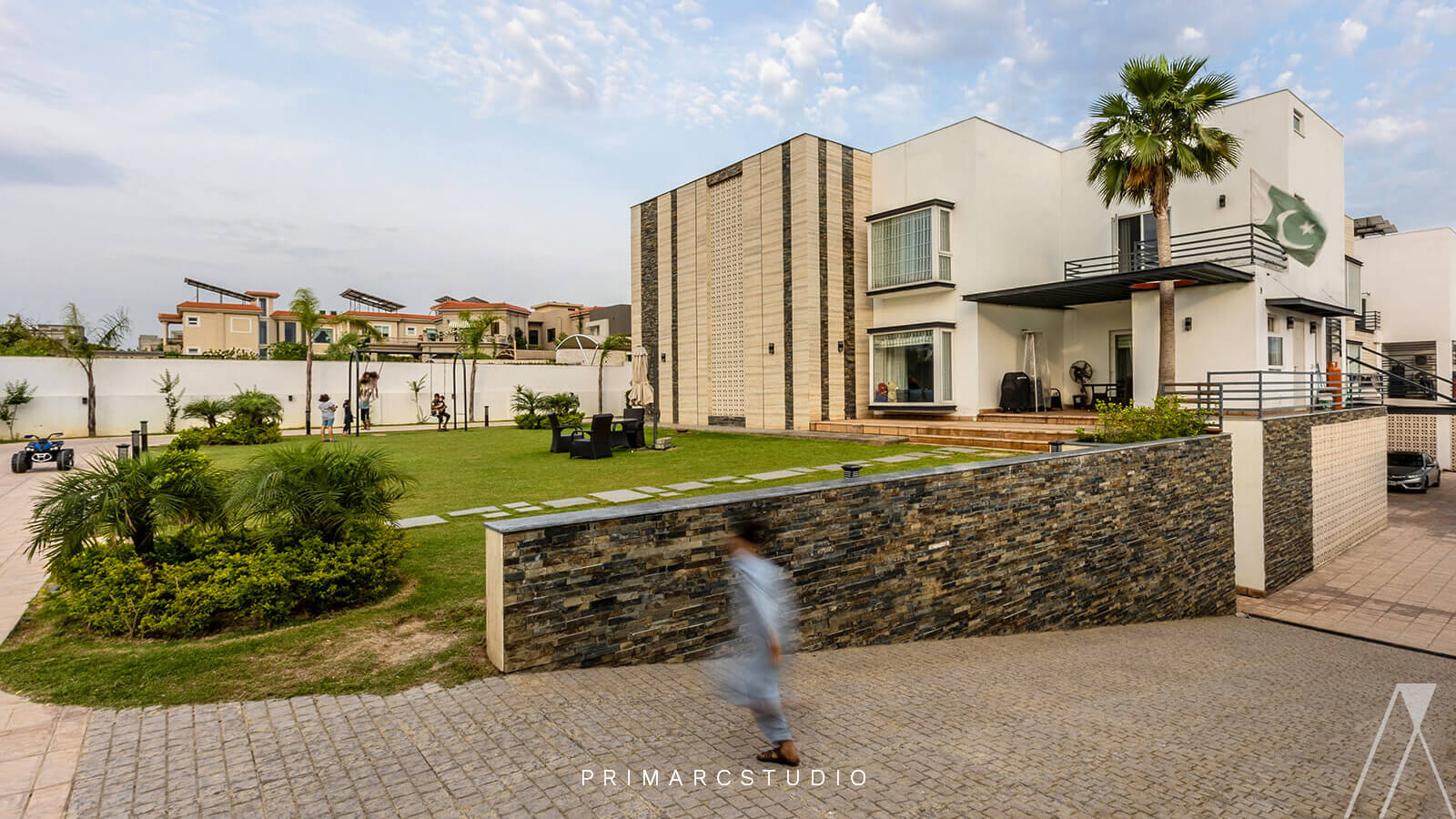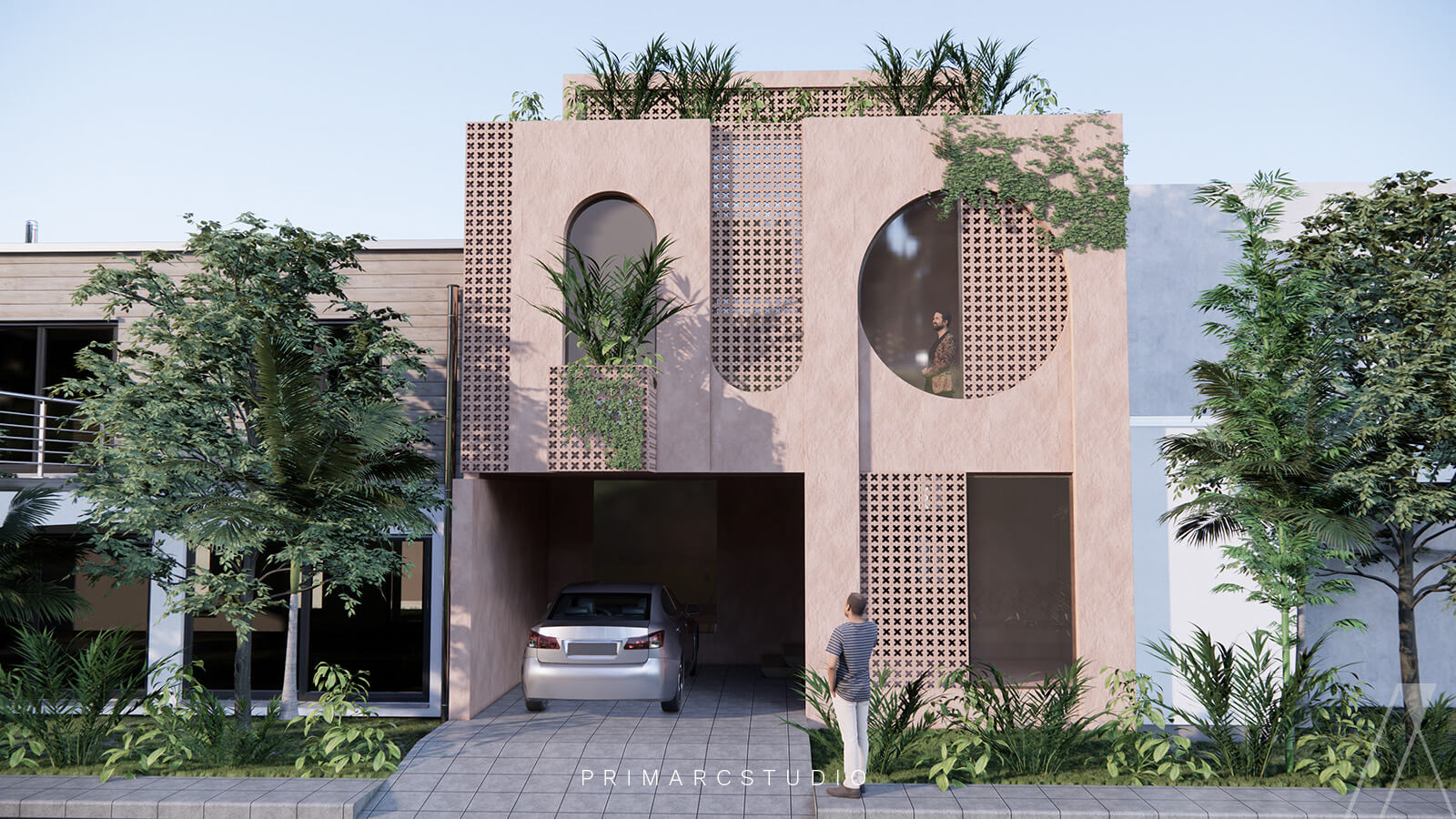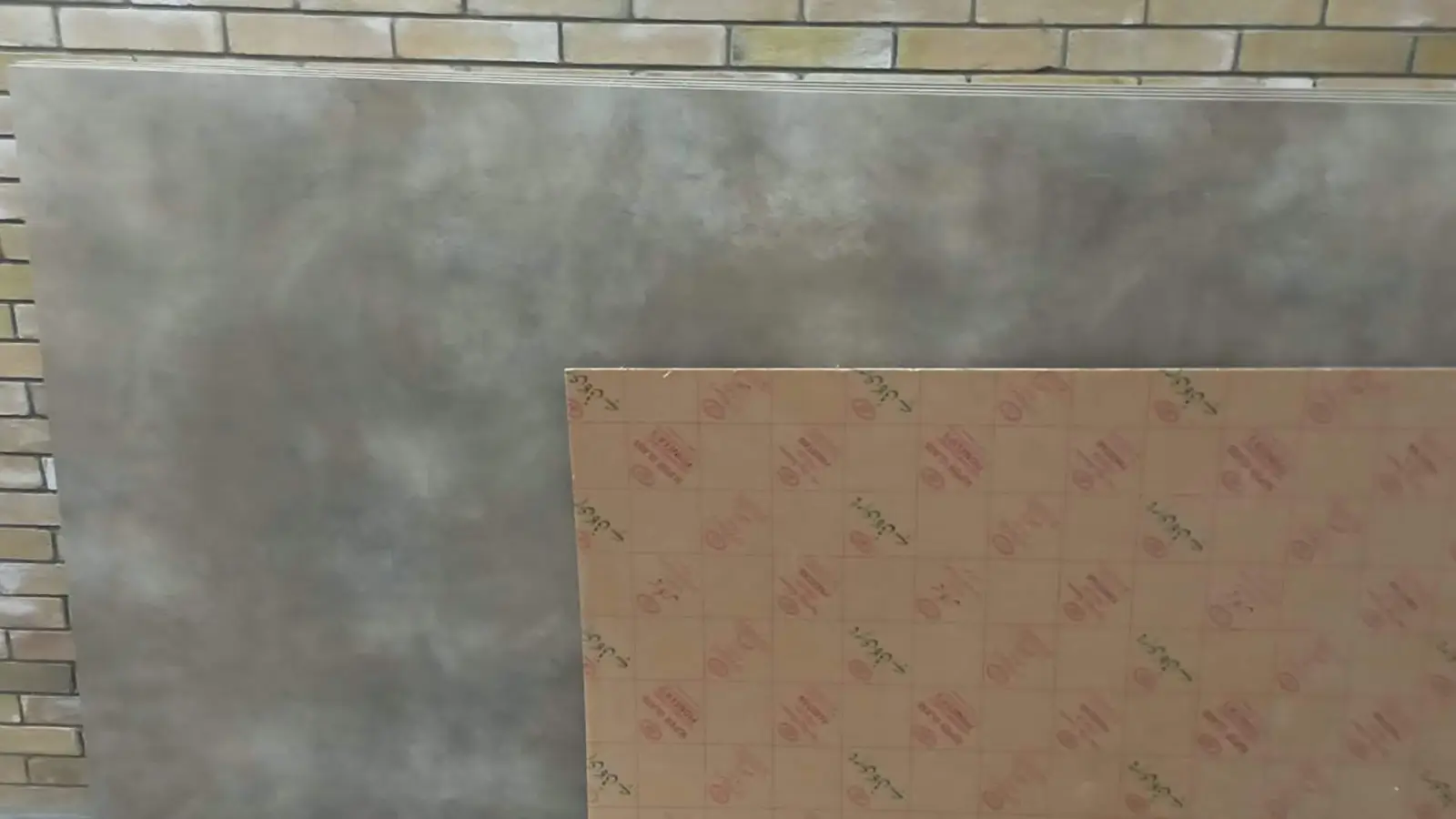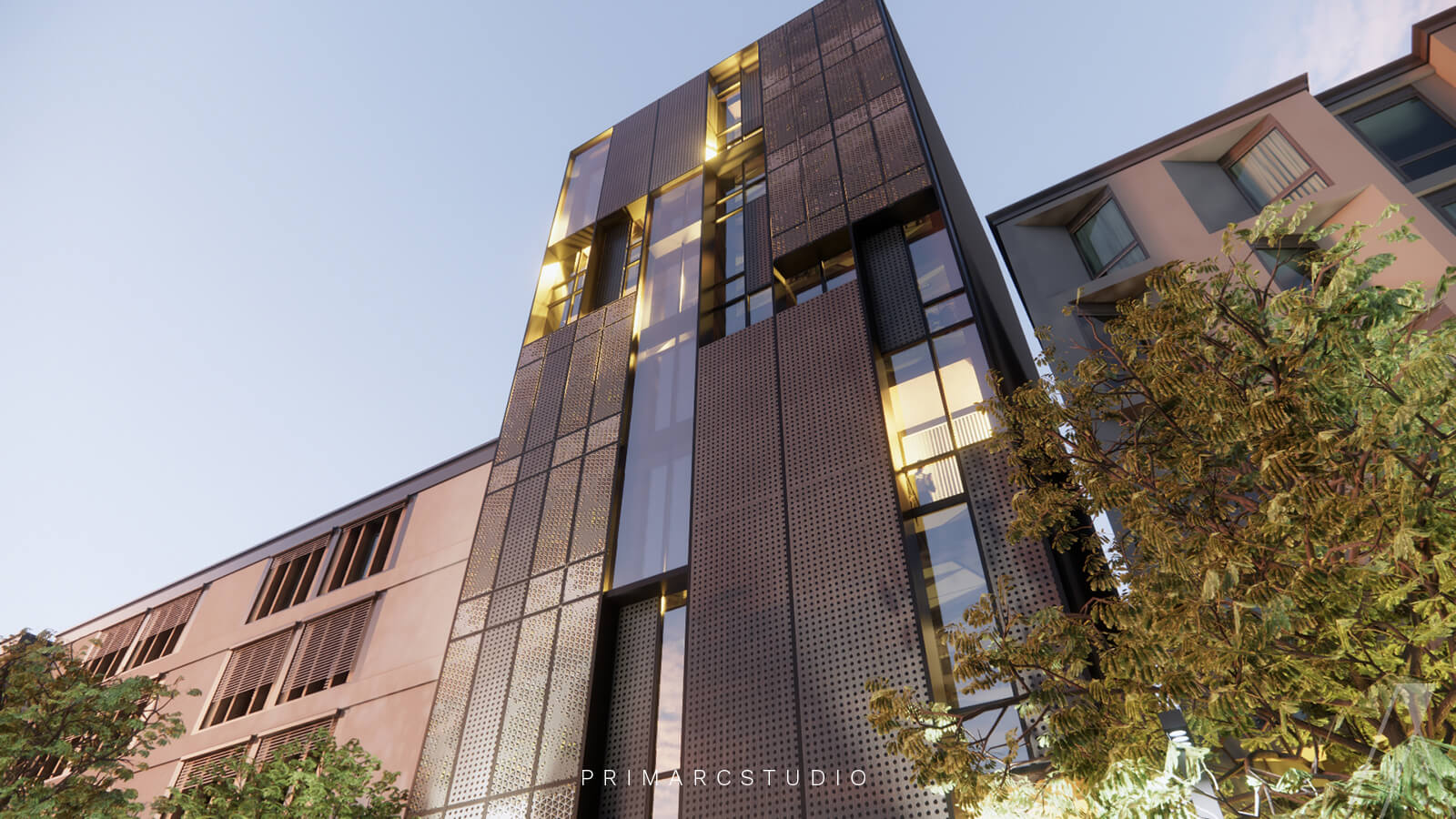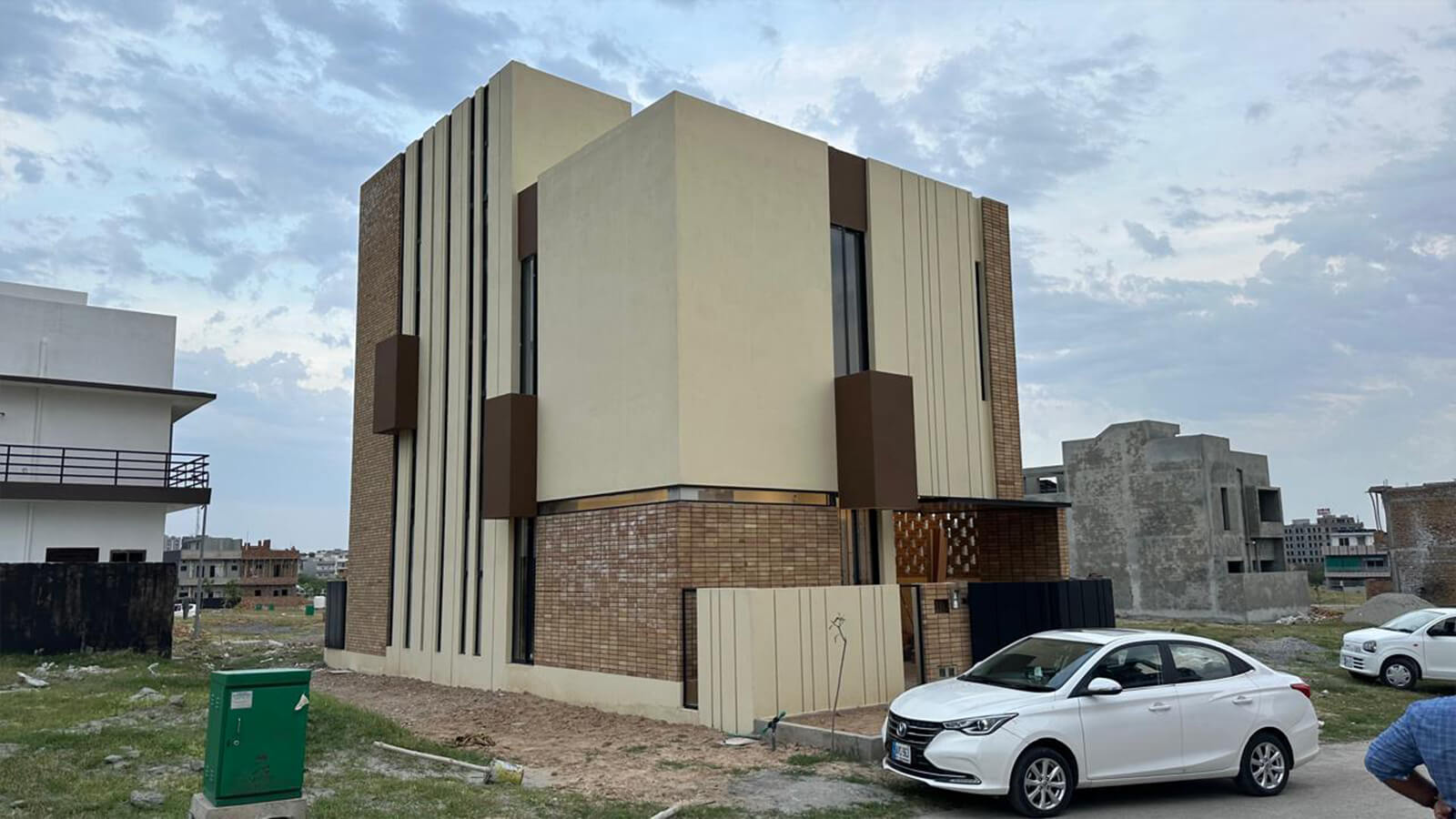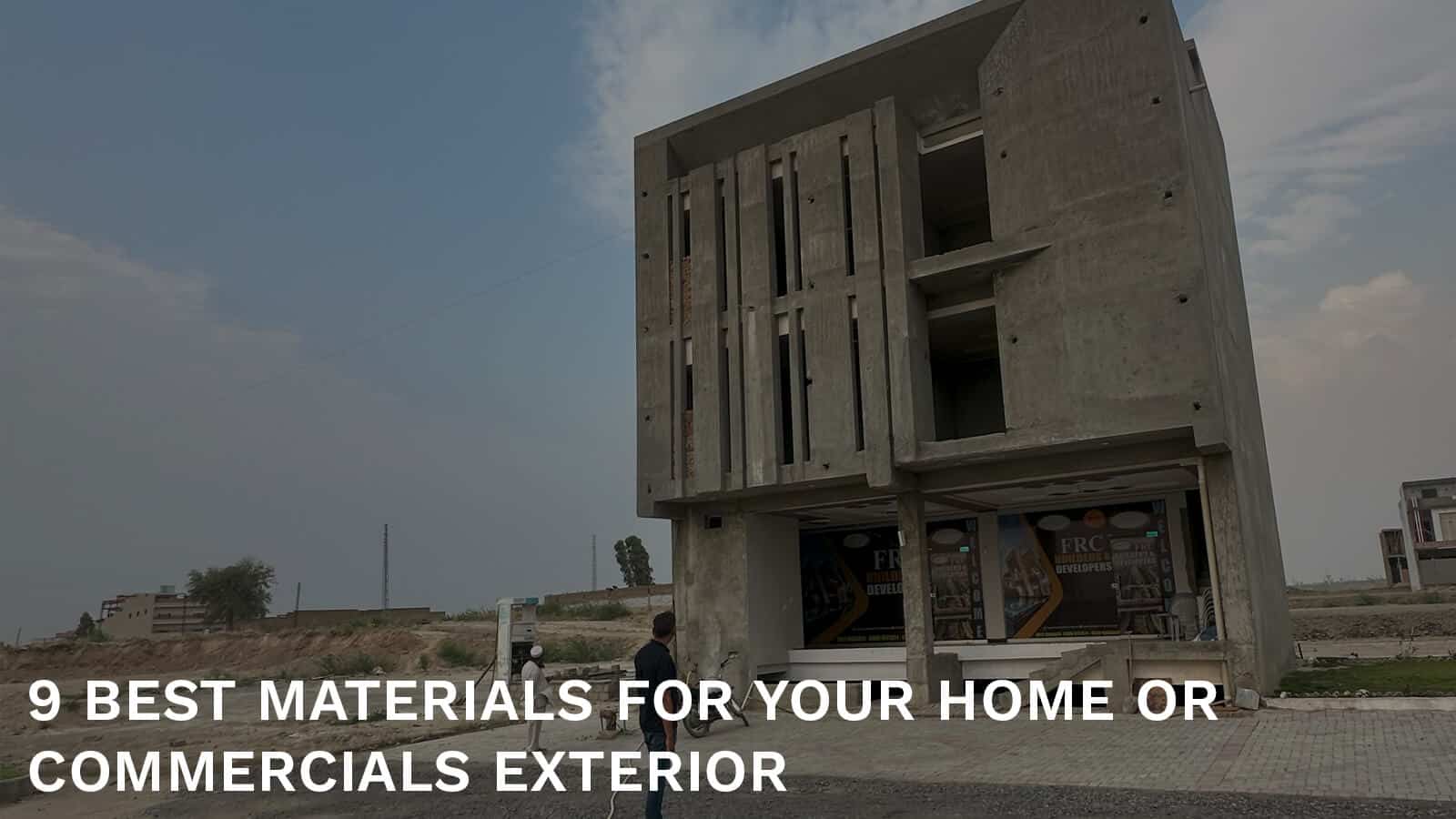
What is Exterior Building Material?
‘Exterior building material’ refers to the materials used in the architectural design to complete the visual aspect and complement the architectural features. It gives the finishing look to the façade or exterior surface of the building. The materials applied to the structure’s or home exterior are selected in lieu of aesthetic and functional appeal.
At Primarc Studio – Architecture and Interior Design Firm, the architects believe this is a key element of the architectural design process. Anyone looking to build any structure, a house or a commercial building should be conscientious in selecting the appropriate exterior materials which will enhance the durability, sustainability, and visual attraction of the structure while staying pragmatic in terms of the budget and interaction with the local climate.
Why Are Exterior Materials Important?
Choosing the right material for your project, especially the exterior, is crucial. There are many materials to choose from, but you should take all the time to search for and investigate the best material for your house’s exterior requirements. Why is this important? Well, you must have heard the story of three pigs: one pig used the straw, another used the sticks, and the last one used the bricks. That story perfectly teaches us to be smart while choosing which materials will come together to make your house perfect. In our lives, the location, quality of materials used, and weather play the role of the bad wolf, mainly for the exterior.
Selecting the right wall cladding material means investing in the structure’s durability without compromising comfort and aesthetics. You must consider whether the chosen materials will complement the environment, withstand the climate, and work within the existing structures.
Selecting the right exterior material also depends heavily on the use of the building. A commercial building would find glass, concrete and stone favourable. In contrast, a residential building would benefit from brick, blocks, marble, or wood. A house’s exterior siding materials are an important indicator of the quality of craftsmanship and upkeep. They ought to be weather-resistant, efficient, and sustainable.
Exterior material choice can also augment and enhance an architectural style. Residential designs can conveniently be replicated through the selection of exterior materials. For instance, the Mediterranean house design can be communicated through stucco, and a Georgian-style residential building can be created using brick. In contrast, a cottage design would benefit from wood siding, clay or wood, etc.
How to Choose the Best Materials for the Exterior of a House?
The architects at Primarc Studio have guided countless clients through the architectural process—from houses and museums to commercial use buildings and hospitals. In our experience, a homeowner should consider several factors when selecting exterior materials. The material to be chosen should check off the following requirements:
Initial and life-cycle costs
Ideally, your priority in terms of budgetary concerns should consider the life-cycle cost of materials, i.e., the total cost of owning, operating, maintaining, and disposing of a material. Generally, materials with a lower initial cost present higher life-cycle costs. When you invest in high-quality material, you ensure a hassle-free ownership experience.
Building type and height
Code requirements will typically decide this aspect of decision-making regarding material selection. However, the focus should remain on how it will impact maintenance and the resulting upkeep cost.
Aesthetics and visual identity
Aesthetics play an important role in the visual impact of a building. Materials that offer colour options, texture variations, easy maintenance, and compatibility with diverse architectural styles are often a better choice.
Interestingly, people tend to overlook the ecological or historical reason behind the use of certain materials in specific locations. These factors elevate the aesthetic appeal of the building without compromising on quality.
Climate
The key factor in selecting materials is considering how they will interact with the location’s climate. Materials chosen for the exterior should be resistant to mould and mildew so as not to pose health concerns for the residents. Certain materials will withstand severe weather conditions; meanwhile, others will not only disintegrate the structure’s durability but also weigh heavily on the pockets. This is why it helps to stick to the tried and tested materials within the region.
Resiliency and durability
Some materials withstand the test of time better than others. For example, more natural materials like brick, stone, concrete, or weathering steel will change over time. Other materials, like metal panels, will be susceptible to rust in humid conditions. Additionally, materials chosen for exteriors ought to be assessed for resistance to pests and decay, made from non-combustible material, and display water resistance and impact resistance such as earthquakes, torrential rains, and wind.
Thermal and acoustic performance
The thermal performance of a building relies on factors such as daylighting and views provided by the materials in use. Meanwhile, the acoustic performance of material matters more in buildings like train stations or airports, where sound transmission needs to be mitigated.
Installation and testing
Material selection is followed by installation, which requires skilled labourers who are knowledgeable in the correct installation methods and procedures. Simply opting for local labour because it is cheaper and convenient can lead to inviability of the structure and setbacks in meeting deadlines.
Sustainability
A material’s sustainability is critical to evaluate through its environmental impact. This can be gauged by assessing its embodied carbon and the total emissions released during manufacturing, transportation, maintenance, and disposal. Also, the longevity of the material plays a huge part in curbing such negative impacts. Whether the materials are recyclable or can be customized over time also ensures the structure’s sustainability. This is why materials like brick, concrete and stone are typically favoured due to their resiliency and longer lifespan.
Our architects at Primarc Studio consider all these factors while ensuring you get the best building materials for your home. Below, we have listed some of the popular materials our clients have found to be an excellent investment in their homes.
Best Materials for House Exteriors or Facade
Concrete
Concrete is one of the widely used materials throughout the world. It is a mixture of sand, small and large stones, gravel, recycled materials, and aggregates. Concrete is mixed with a binder, mostly cement and water, and applied on surfaces. The mixture is then left to dry and harden. Concrete is used in almost anything, from walls to pavements to halls.
Concrete is the most commonly used exterior wall cladding material because of its durability and strength. It is low maintenance and long-lasting, making it budget-friendly. It requires minimum maintenance compared to other materials used on the exterior of houses. Concrete can be recycled, making it eco-friendly. Plus, you can paint or stain concrete to add style and character that reflect your personality.
Bricks or Gutka
Bricks are one of the man-made construction materials that has been used since 7000 BC and even by other earlier civilizations. These are small baked units made out of clay. Bricks are mostly used to build the exterior walls of houses as they not only give your house a classy look but can hold heat and slowly release it into the atmosphere, making the interior cool. It keeps the temperature in control. It is also a non-combustible material heated at 2000 F, making it both resistant and confined to fire. This brick property can keep your house safe from any big fire issues.
Bricks that are used on houses’ exteriors are called gutka in Pakistan and are sustainable, make your houses eco-friendly, have a long lifespan, and keep the houses low maintenance.
Because it is an incredibly versatile and durable material, Gutka is a popular, low-risk choice for house exteriors. The availability of options in gutka in terms of colours, textures, uses, and sizes allows the gutka to be used in both modern residential designs and traditional designs.
Primarc Studio incorporated a gutka (or brick) wall or flooring in many projects to create a cohesiave and textural finish; we have used gutka on the exterior of our latest 5 marla house designs, which can be viewed here.
We have also used gutka on the exterior of commercials, which can be seen here. Bricks and gutka require very little maintenance, absorb exterior noise, and provide optimal protection from the elements, making them ideal for commercial use.
Wood
One of the oldest and most favoured materials for the exterior is wood. Using wood as wall cladding for house exteriors allows for various options in terms of design, viability of structure and low upkeep. It also allows for excellence in craftsmanship, which adds value to the building where it is used freely.
Wood is often chosen for its aesthetic appeal and the wide knowledge of this material and machinery use. It can also be customized to adapt to any setting through paint, stain, or natural form. It is one of the most charming materials that can be used for house exteriors; it makes your house look classy and pleasing.
Wood is easy to install and does not require much labour and machinery but a lot more expensive and requires yearly upkeep, to reseal it to stop it from rotting. Almost anyone with good carpentry skills can easily install wood slidings. Wood can adjust to practically any setting, whether you paint it, stain it, or leave it natural, and it will keep your house appealing anyway.
Stone
Stone is yet another naturally occurring material used to make the exteriors of houses pleasing. It gives houses a stately and sophisticated look. It has great compatibility with architectural styles. Stones are available in many colours, types, and varieties of textures. Limestones, marbles, and sandstones are some common choices.
Stones as an exterior material can enhance the house’s look and give it a sophisticated appeal. It offers better longevity than other materials, such as wood and vinyl. Its strength and durability is unquestionable. Stones are non-combustible, resistant to damage, and can withstand pests and decay.
Another reason why stone is popular is because it is available in many colours and is easy to chisel and cut into various shapes. It can be laid in diverse patterns to achieve a range of styles. Stone is often used in residential designs like a rustic farmhouse or a luxurious estate.
Vinyl
Vinyl is a plastic exterior material suitable for houses in wet climates. It is highly recommended that decorations be imitated using other materials, especially wood. It is made of PVC resin and was created in the early 1950s to replace aluminium and wood sidings.
Vinyl is a cheap material for use on the exterior surfaces of houses. It comes in various colours, textures, variations, and styles. From basic clapboard profiles to different thicknesses. Vinyl can make your home look like stone, brick, or wood. Vinyl is one of the least expensive materials to purchase and install. It is easy to clean, which makes it low-maintenance. It helps in customization and DIY projects as it is easy to install. Vinyl is also a fire-resistant material.
The life of vinyl is worse than that of any materials listed here. If there is any puncture in the vinyl, it’s immediately ruined. Compared to the other materials listed here, vinyl is a cheap solution and should not be viewed as permanent.
Stucco
Stucco is a material made of Portland cement, sand, lime, and water. When applied correctly, this material has lasting durability, low maintenance, and resistance to the elements. It is crucial to properly place expansion joints when using stucco in functional and less noticed locations.
During application, your applicator can create a modern, smooth, clean finish for a contemporary look or add a more rustic texture for a more Mediterranean or Pueblo feel.
Stucco is very versatile and depends on the client’s or architect’s imagination for how they want to use it.
Ceramic Tiles
Tiles have been a recurring favourite exterior wall cladding material for house owners because of the diversity of options they offer to create the perfect customized facade per the client’s preferences. They are available in various colours, textures, sizes and thicknesses and are economical, weather-resistant, and safer alternatives to other hazard-prone materials. Tiles also create the perfect finishing, i.e., tiled walls, patios, and walkways.
A well-executed exterior tile installation can attract customers to approach a building. Tile selection depends on local climate, viability, maintenance, setting, grout selection, etc. House owners must be cautious in terms of selecting the right tiles as they require compatible installation materials (from the right substrate to the most potent sealant) to ensure that the house owners are not faced with issues such as broken tiles or loose tiles in the future.
These problems can be avoided by choosing the best tile mortars for exterior tiles, as they combine bond strength with flexibility to allow for shifts in the substrate caused by changing moisture and temperature levels. Additionally, clients may prevent mold and mildew from spreading with the help of the right exterior grouts that can hold up to frequent moisture exposure.
Although the majority believe porcelain is the safest bet regarding the right type of tiles, unglazed tiles are often ideal for outdoor floor installation as they normally have non-slip properties. Coincidentally, this should also be considered when using tiles internally within the house. Tiles with natural abrasive surfaces will often provide good traction in wet conditions and reduce the likelihood of damage as well. Alternatively, clients prefer to opt for textured tiles as they minimize the risk of slipping. However, on the exterior walls, people can lean into the aesthetic appeal as almost any type of tile can be used, including ceramic, glass, or stone.
Aluminium
Popularly known as the ‘grey gold’, aluminium is a lightweight metal gaining popularity as an exterior material for buildings. This is largely due to its properties, which make it strong yet malleable, allowing it to be formed into complex shapes for uses like building frames, siding, windows, and doors. Homeowners and building owners need to be aware of the advantages of using this material as it offers improved ventilation, acoustics, and greater resistance against physical impacts.
Aluminium is a perfect wall cladding material due to its ease of installation, cost-effectiveness, and machinability. It is also a highly versatile and flexible material, as it can be modified in terms of colour choices and curvature. It elevates the aesthetic appeal of the structure by bringing to life any design potential envisioned. It is easy to transport and durable in terms of strength. It can support large panes of glass and resist corrosion due to inclement weather.
Additionally, this material can boast a longer lifespan and low maintenance. Due to its recyclable nature it is also a key material used in countries which are eager to reduce their carbon footprint and boost greener initiatives. It’s not widely known that aluminium is also a fantastic insulator and will both withstand outside elements and keep heat inside, making indoor temperature regulation much easier and more efficient, which is a key concern for the residents of Rawalpindi and Islamabad.
Having said all this, commercial buildings have used aluminium cladding so extensively nationally that everyone has started associating aluminium panels with commercial buildings only.
Paint
Paint is a hassle-free and economical alternative to all other exterior building materials. However, the majority of people need to assume that all paints are the same and can be applied internally and externally. This is where the guidance of an architect can make a difference.
Exterior paints are different from interior paint. The exterior paint has a definitive role in protecting houses or buildings from various aspects. Exterior paints protect from weather factors, extend the life of the building, elevate the aesthetic view of the facade, and diminish the flaws while adding value to the building.
This might be strange to consider, but external paint can add value to your house through the choice of colour, design, texture, and durability. People keen on selling or renting ought to be cautious in this regard, as selecting the right paint can either attract interest or discourage it.
Beyond colour and aesthetics, your selected paint ought to meet the following criteria:
– It must complement your home’s exterior the location, the condition and the type of the building.
– It should be applicable, clean and easy to maintain.
– It should be environmentally friendly.
House owners can choose their ideal paint from many different types of paints and brands. You can choose from brands such as Berger, Dulux, Brighto Paints, Jotun Paints, and Nippon Paints, to name a few. And in types, you have acrylic, latex, and oil-based.
Acrylic paints are typically elastic, expanding and contracting as temperatures fluctuate. They are best used on siding made from wood, aluminium or fibre cement or to cover stucco, plaster and drywall. Latex paints are water-based, dry quickly, expand in warm temperatures and contract in cool temperatures. They are also cheaper. Conversely, oil-based paints are not widely used today because they emit hazardous fumes when wet. However, they should be applied in areas with proper ventilation and appropriate safety gear such as masks, gloves, etc.
Oil-based paint works well on porch floors, doors, trims, etc.
Another aspect to take into consideration is the type of finishing. This finishing will determine the final look of the facade. A flat or matte finish will give a non-reflective look to the house. This type of finish works best for renovation projects on old houses.
Satin finishes are popular among homeowners as they work well on wood and cement siding without appearing dull or reflective. Alternatively, Semi-Gloss paints provide a durable and easy-to-clean surface as they are water-resistant and perform well in exposed areas.
What are the Best Materials to Use in Rawalpindi/ Islamabad?
As an architecture firm located in Gulberg Greens, Islamabad, our architects often get asked about the best material to use locally on modern house exteriors and commercials. Our most popular materials in our projects include natural stone, gutka, tiles, and stucco. These materials are durable enough to withstand the rainy weather and reflect traditional materials used and the popular contemporary style we often see locally implemented.
How do the Costs of Different Exterior Wall Materials Compare?
Now that we have covered the basics with a collection of materials you can choose for the exterior of your house, you probably need to figure out how much all of this will cost. Rest assured, we are here to help you plan your budget accordingly. You may check the following list to decide which material can help you create the perfect facade of your house without draining your account. Although different materials have different varieties, and each costs differently, a rating system will help you make up your mind and explore your local market as you know all the pros and cons of these exterior materials.
| Materials | Life * | Maintenance** | Cost*** |
| Concrete | ★★★★☆ | ★★★★★ | ★★★★★ |
| Brick | ★★★★★ | ★★★★★ | ★★★★☆ |
| Stone | ★★★★★ | ★★★★★ | ★★★★☆ |
| Wood | ★★★☆☆ | ★★☆☆☆ | ★★★★★ |
| Vinyl | ★☆☆☆☆ | ★★☆☆☆ | ★★★☆☆ |
| Stucco | ★★★☆☆ | ★★★★☆ | ★★★★☆ |
| Tiles | ★★★★★ | ★★★★☆ | ★★★★★ |
| Aluminium | ★★★★☆ | ★★★★★ | ★★★★☆ |
| Paint | ★★☆☆☆ | ★★★☆☆ | ★★★★☆ |
* – More stars mean a better life.
** – More stars mean less maintenance.
*** – More stars mean more expensive
The above-discussed materials are just a handful of the many man-made and natural options available. Choosing the right material for the exteriors of your house according to their requirements can tell how efficient your choice is and there are certain materials that are applied according to the architectural style of the house, to learn more about Pakistani House Designs, you can read more here.
If you want a home that lasts long and stands out on time, you need to be careful with the material you choose. Always strive for the quality of the materials, and remember, Pinterest-inspired projects can be a huge hit, but you need to prioritize your requirements.
Happy building!!
Ozaira Mahin
Ozaira Mahin is the Editor and Content Strategist at Primarc Studio, Islamabad. With a passion for storytelling in architecture and design, she brings creative insight to every project and article, helping translate complex ideas into meaningful narratives for readers across Pakistan.



